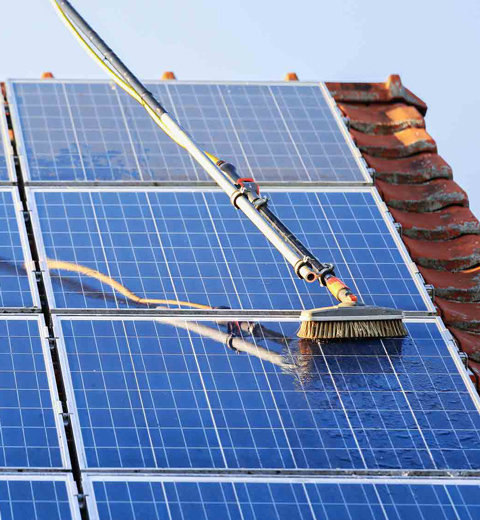FAQ
All About Solar: FAQs for Homeowners
Learn About Solar Installations, Energy Storage, System Maintenance, and More
Solar panels significantly reduce electricity bills by generating your own power, lowering your carbon footprint and contributing to a sustainable future. They can increase your home’s value by 3–5%, according to studies like those from the National Renewable Energy Laboratory (NREL). Additionally, solar offers energy independence, protecting against rising utility costs, and may allow you to earn credits through net metering for excess energy sent to the grid.
The cost of a residential solar system typically ranges from $15,000 to $30,000 before incentives, based on a 5–11 kW system size, with averages around $2.09–$3.33 per watt in 2025. Costs vary by location, roof complexity, and equipment. For example, EnergySage reports an 11 kW system at ~$27,714 before the federal tax credit. Local rebates and the 30% federal Investment Tax Credit (ITC) can lower costs significantly, though the ITC may end in 2025.
The federal ITC provides a 30% tax credit on solar system costs through 2032, per the Inflation Reduction Act, though some sources suggest it may end in 2025. States like California offer additional rebates, such as the Self-Generation Incentive Program (SGIP) at $150 per kWh for battery storage. Local utilities may provide performance-based incentives or net metering credits. Check with your installer or local authorities for specific programs.
Your home’s suitability depends on roof condition (should be in good shape, ideally less than 10–15 years old), orientation (south-facing is optimal in the northern hemisphere), minimal shading from trees or buildings, and local solar irradiance. A professional site assessment, as recommended by Palmetto, evaluates these factors to ensure efficient energy production.
Physical installation takes 1–3 days for a typical residential system, but the full process, including permitting, utility interconnection, and inspections, can take several weeks to a few months. Timelines vary based on local regulations and utility coordination, as noted by Boston Solar.
A battery stores excess solar energy for use during outages, at night, or during peak rate periods, enhancing energy independence. It reduces reliance on the grid and can lower bills, especially with time-of-use rates, by using stored energy when electricity is expensive. Batteries also support sustainability by reducing peak grid demand.
Solar batteries provide backup power during outages, maximize solar energy use by storing excess production, and reduce grid dependence. They can save money by using stored energy during high-rate periods and enhance system efficiency. For example, Good Energy notes that a battery can increase solar coverage to 80% of household usage.
Solar batteries cost $10,000–$20,000, depending on capacity (e.g., 10–13.5 kWh) and brand. A Tesla Powerwall (13.5 kWh) averages ~$11,500 installed, per This Old House. Costs range from $1,000–$1,961 per kWh, with Tesla at the lower end. Federal tax credits (30% through 2025) and local rebates can reduce costs.
Yes, most solar systems can be retrofitted with a battery, though it may require a hybrid inverter or additional equipment. Compatibility depends on your current inverter and system design. A professional assessment, as advised by Solar Choice, ensures proper integration.
Common issues include reduced output from dirt, dust, or shading; inverter failures (e.g., error codes or shutdowns); electrical connection problems (loose or broken wires); and physical damage like cracks or delamination. Regular monitoring can catch these early, as noted by Sistine Solar.
Check your inverter display or monitoring app for production drops. Higher-than-expected electricity bills may also signal issues. Compare output to your installer’s estimates. Clean Energy Reviews suggests checking for shading or tripped breakers.
Verify the circuit breaker is on and inspect for dirt, shading, or debris. Check the inverter for error messages. If issues persist, contact your installer or a certified technician, as recommended by Arka360, to diagnose and repair the system.
Contact your original installer for warranty-covered repairs or a certified solar technician. They have the expertise to handle complex issues like inverter failures or electrical problems, ensuring safe and effective repairs.
Yes, dirt, dust, bird droppings, or debris can reduce efficiency by blocking sunlight. Regular cleaning ensures panels operate at maximum capacity, as emphasized by EnergySage.
Clean panels once or twice yearly, more frequently in dusty, coastal, or low-rainfall areas. Rainfall can naturally clean panels, but Energy Saving Trust recommends 12–18-month intervals for optimal performance.
Yes, if panels are accessible, use a soft brush or sponge with mild soap and water. Avoid abrasive materials to prevent scratching. SunPower advises caution and safety harnesses for roof access.
Rinse panels with a garden hose, scrub gently with a soft brush and mild soap, then rinse thoroughly. Avoid high-pressure water or harsh chemicals to protect panels, as advised by RatedPower.

Ready to go solar? Contact us for a free consultation.
Reach Us
Location:
3543 Old Conejo Rd. Ste. 104, Newbury Park, CA 91320
Email:
info@newburyparksolar.com
